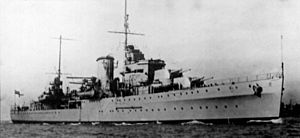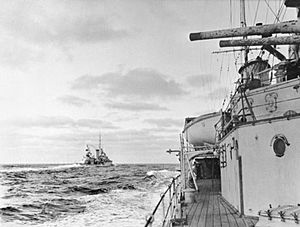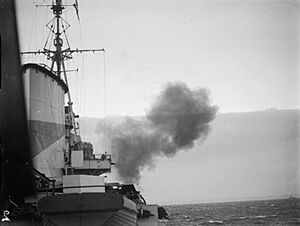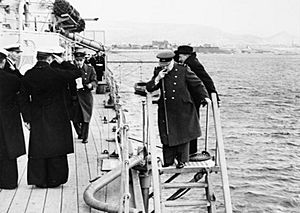HMS Ajax (22) facts for kids
 |
|
Quick facts for kids History |
|
|---|---|
| Name | HMS Ajax |
| Builder | Vickers Armstrong, Barrow-in-Furness |
| Laid down | 7 February 1933 |
| Launched | 1 March 1934 |
| Commissioned | 3 June 1935 |
| Recommissioned | 11 January 1938 |
| Decommissioned | February 1948 |
| Identification | Pennant number: 22 |
| Motto | Nec Quisquam Nisi Ajax (Latin: "None but Ajax [can overcome Ajax]") |
| Fate | Scrapped in 1949 |
| General characteristics | |
| Class and type | Leander-class light cruiser |
| Displacement |
|
| Length | 554.9 ft (169.1 m) |
| Beam | 56 ft (17 m) |
| Draught | 19.1 ft (5.8 m) |
| Installed power | 72,000 shaft horsepower (54,000 kW) |
| Propulsion |
|
| Speed | 32.5 knots (60 km/h) |
| Range | 5,730 nmi (10,610 km; 6,590 mi) at 13 knots (24 km/h; 15 mph) |
| Complement |
|
| Sensors and processing systems |
|
| Armament |
|
| Armour |
|
| Aircraft carried | One catapult-launched Fairey Seafox, replaced by a Supermarine Walrus |
| Service record | |
| Operations: |
|
HMS Ajax was a famous light cruiser that served in the Royal Navy during World War II. She became well-known for her role in several important battles. These included the Battle of the River Plate, the Battle of Crete, and the Battle of Malta. She also helped protect supply ships during the siege of Tobruk. Ajax was the eighth ship in the Royal Navy to have this name. In February 1942, the town of Halifax in England adopted her.
Contents
Building and Early Missions
Ajax was built at the Vickers shipyard in Barrow-in-Furness, England. Her construction began on February 7, 1933. She was launched into the water on March 1, 1934, and finished on April 12, 1935.
She was first sent to the North America and West Indies Station. However, after getting ready in May 1935, she went to the Mediterranean Sea instead. This was because of the Abyssinian crisis. She stayed there until November, then finally joined her squadron in Bermuda. Until 1937, she took part in training exercises and visited ports in North and South America.
After her time in the West Indies, Ajax returned to Britain for repairs and upgrades. Her 4-inch guns were improved by changing single mounts to double mounts. She went back to the West Indies in February 1938. In 1939, she moved to the Pacific Ocean, near South America. On January 27, Ajax helped rescue people after an earthquake in Talcahuano, Chile. She then returned to Bermuda and was sent to the South Atlantic in March.
When World War II started in September 1939, Ajax patrolled near the River Plate. On September 3, she sank the German merchant ship Olinda. She also stopped two other German ships, Carl Fritzen and Ussukuma. Their crews sank both ships to prevent the British from capturing them. After a short time near the Falkland Islands, Ajax returned to her patrol area off the River Plate on September 21.
The Hunt for Admiral Graf Spee

The German warship Admiral Graf Spee was causing problems for Allied shipping. To deal with this threat, Force G was created. It included Ajax (which was the flagship, meaning the main ship, led by Commodore Henry Harwood), Exeter, and Achilles. Another cruiser, Cumberland, was being repaired at Port Stanley.
Force G found Graf Spee on December 13. They attacked her even though the German ship had more powerful guns. Ajax was hit seven times by the Germans. Her X and Y gun turrets were damaged, and parts of the ship were hit. There were 12 casualties, with 7 sailors sadly killed. Exeter was more badly damaged and had to leave the battle. This left Ajax and Achilles to keep track of Graf Spee when she went into Montevideo harbor.
It's not fully clear why the German ship pulled back and didn't use her advantage. However, her front part was damaged, which affected how well she could sail. Her fuel systems were also hit. Ajax and Achilles, later joined by Cumberland, waited outside the harbor. They tricked the Germans into thinking a much larger British force was waiting. Because of this, Graf Spee was sunk by her own crew. Ajax refueled and continued her patrols.
In January 1940, Ajax returned to Britain for repairs. She sailed via Montevideo, Rio de Janeiro, and Freetown, Sierra Leone. Other ships joined her on the way, including the aircraft carrier Ark Royal. Ajax arrived at Plymouth at the end of January. The next month, she went to Chatham Dockyard for her refit.
Battles in the Mediterranean
After her repairs and training, Ajax was ready for duty in August 1940. Her refit included new radar and improvements to her anti-aircraft guns.
In August 1940, Ajax was sent to the 7th Cruiser Squadron for service in the Mediterranean Sea. This was important because France had fallen, and Italy, with its strong navy, had joined the war. She sailed from Britain on August 21, helping to protect a convoy of ships going to Egypt. In late September, she escorted a group of troop ships from Aden to Suez. Ajax then joined HMAS Sydney at Alexandria on September 30.
From October 2 to 16, Ajax took part in large navy exercises. The goal was to stop Italian supply convoys going to Libya and protect British convoys going to Malta. On October 8, Ajax again sailed with a large naval force. They were covering the passage of a convoy to Malta. Ajax and Orion patrolled south-east of Malta. They then covered the return of another convoy to Alexandria on October 12.
Night Action at Cape Passero
During the night of October 11–12, Ajax found a small Italian force. In a close-range night battle, two Italian torpedo boats, Airone and Ariel, were sunk. The destroyer Artigliere was badly damaged and later sunk by HMS York. Two other Italian warships escaped. Ajax herself was hit by seven shells. These hits destroyed one of her small boats and badly damaged her bridge and radar. There were 35 casualties, including 13 sailors killed. She returned to Alexandria on October 16.
At the end of October, Ajax began two missions to carry more troops to Suda Bay on Crete. She was nearly hit by bombs from enemy aircraft. When she returned to the fleet on November 6, she helped protect a convoy going to Malta. This was a big operation involving most of the Mediterranean Fleet. She was part of Force X, which left the main fleet on November 11. They sailed into the Straits of Otranto to create a distraction. This helped cover a successful air attack on Taranto, Italy.
Strait of Otranto and Durazzo
On November 12, Force X was returning to the main fleet. They found a small convoy of four Italian merchant ships. These ships were protected by the naval auxiliary Ramb III and the older torpedo-boat Nicola Fabrizi. Ramb III fired its guns and managed to escape without damage. Nicola Fabrizi stayed with the merchant ships and attacked the British. Nicola Fabrizi was hit right away and badly damaged. The Italian torpedo boat kept fighting until it could no longer. After Nicola Fabrizi was stopped, the British ships attacked and sank all four Italian merchant ships. This battle happened near the Strait of Otranto.
Force X also fired shells at the port of Durazzo (now Durres) and set an oil refinery on fire. Then, they rejoined the main fleet. Ajax and other ships refueled at Suda Bay before returning to Alexandria.
From November 15 to 20, Ajax and four other cruisers carried troops from Alexandria to Piraeus, the port of Athens. They then returned to Alexandria. On November 23, she was sent with Force B to cover a convoy to Crete. She also supported air attacks on Tripoli from the aircraft carrier Eagle.
Ajax took part in the Battle of Cape Matapan. On May 21, 1941, she was hit by bombs from German Ju 87 dive bombers. She helped evacuate many troops from Crete until May 29. She then covered operations in Syria in June. In November, she joined Force K at Malta. In February 1942, she was sent away for repairs.
Two Years of Repairs (1942 & 1943)
On February 6, 1942, Ajax left Suez for the United Kingdom. She sailed around the Cape of Good Hope, stopping at Mombasa and Freetown. She arrived in the Clyde on April 14. On June 6, she began major repairs at Chatham Dockyard, which lasted until September. Her anti-aircraft (AA) guns were greatly improved with eleven new Oerlikon 20 mm cannons. Many different radar systems were also installed. These included radar for her main guns, AA guns, and for controlling barrages. An improved aircraft warning radar and surface warning radar were also added. Her ability to carry aircraft was removed.
Ajax had trials in October after her repairs. She was put back into service on October 24. She then trained with the Home Fleet in Scapa Flow during November. On December 31, she joined Force Q in Bône, Algeria. Her job there was to stop enemy convoys and protect Allied convoys.
On January 1, 1943, while at Bône, Ajax was hit by a 1,000-pound bomb dropped by an enemy aircraft. The bomb hit her "B" boiler room, disabling the ship. On January 7, she was towed to Gibraltar for temporary repairs. These repairs continued into February. Permanent repairs were planned for the United States. She was taken to Norfolk Navy Yard, Virginia, where repairs lasted until September. During this time, Ajax was fitted with American 40mm anti-aircraft guns. She also received new radar systems for fire control and identifying friendly aircraft. After trials in October, she returned to Britain in November. More British equipment was installed. Ajax was put back into service at Portsmouth on December 25. She rejoined the Home Fleet for training. In February 1944, she returned to the Mediterranean, after almost two years out of action.
D-Day and Post-War Service
As part of Force K, Ajax fired her guns at Gold Beach during the D-Day invasion. She helped silence a German gun battery at Longues. She later supported the landings in southern France. Ajax also operated in the Aegean during the reoccupation of Athens and the communist uprising in Greece.
After the war, Ajax was used to take German sailors from the crew of Admiral Graf Spee back to Germany. This was an interesting twist, as Ajax had fought against Graf Spee in 1939. Ajax was then assigned to the Royal Navy Palestine Patrol. Her job was to stop illegal Jewish immigration to Palestine. In July 1947, she was involved in the Exodus 1947 incident. She was part of the Royal Navy force that stopped the immigrant ship and later escorted it back to Germany.
Final Resting Place
Ajax was taken out of service in February 1948. There were talks about selling her to the Chilean Navy or Indian Navy. However, the sale to India did not happen. It is believed that Winston Churchill did not approve of the sale. He felt that such an important ship should be broken up to preserve her history. After running aground at Newport, Monmouthshire, on November 9, 1949, while being towed to the scrapyard, she was refloated. She arrived at Cashmore's in Newport, South Wales, to be broken up on November 18, 1949.
Ajax Remembered
The town of Ajax, in Ontario, Canada, was named after the cruiser. This happened after the Battle of the River Plate. The town also has streets named after every member of the ship's crew. For example, Hobson Avenue and Harwood Avenue, which is the town's main north-south street. Many street signs in the town have the silhouette of the ship. This silhouette shows that the street is named after someone from the ship's crew. The ship's anchor rests in front of the local branch of the Royal Canadian Legion.
Calle Exeter (Exeter Street) in Concepción, Chile, was named in honor of HMS Exeter. This was because HMS Exeter and HMS Ajax helped the people of Concepción after the 1939 Chillán earthquake.
Ajax's bell is on a monument in Montevideo, Uruguay, just outside the port customs house. It was given as a gift by Admiral Sir Henry Harwood and Sir Eugen Millington-Drake in 1949.
Ajax Icefall is a glacier at the head of Visca Anchorage, King George Island. This is in the South Shetland Islands. It is named for HMS Ajax, which helped search for a boat crew from the Discovery II. They went missing on King George Island in January 1937.



